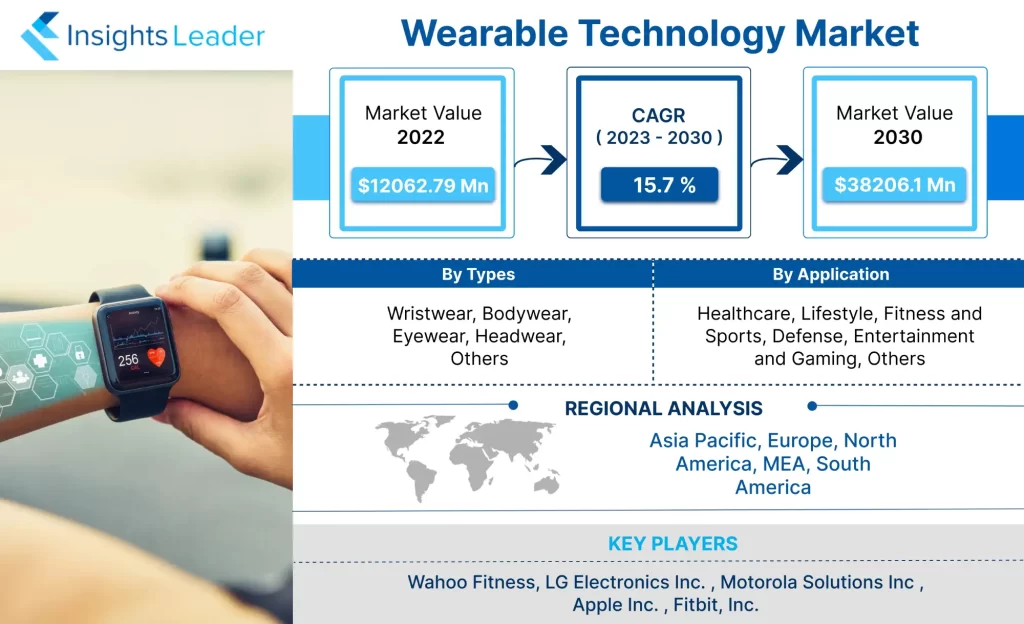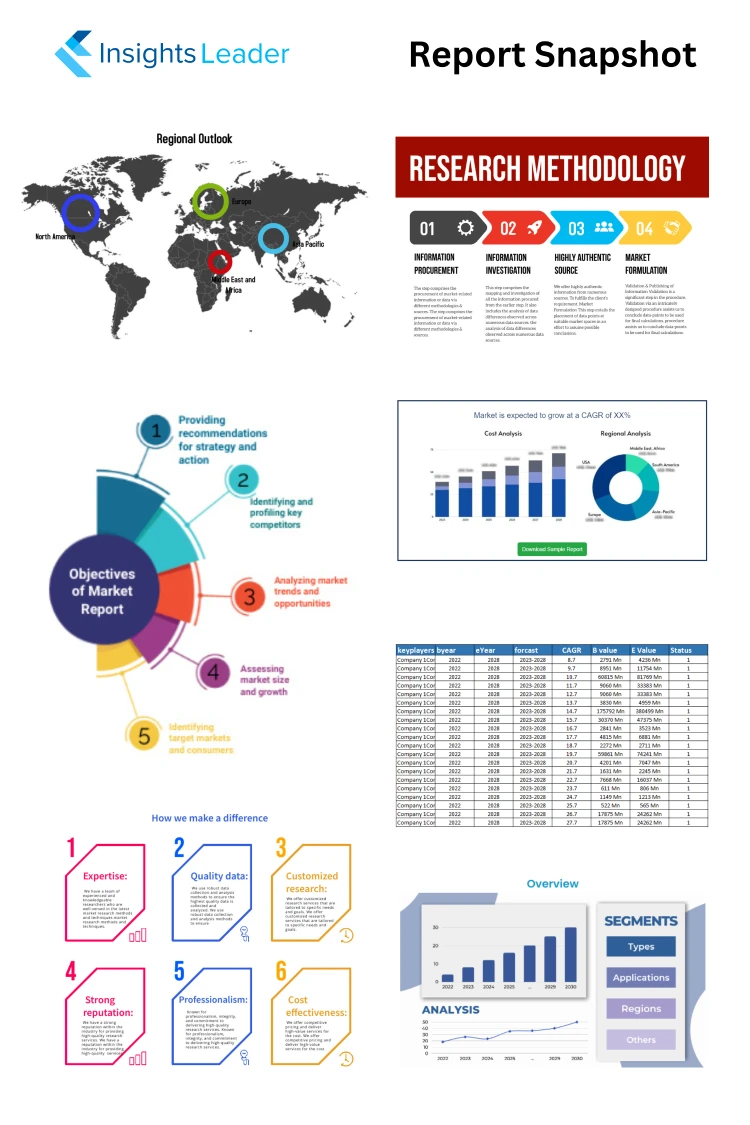Wearable Technology Market Size 2024 to 2031
Growing health awareness and adoption of technology is driving the market growth of wearable technology. Wearable devices, such as fitness trackers and smartwatches, have become increasingly popular in recent years as people have become more interested in monitoring their health and wellness. One of the primary reasons for this growth is the increasing prevalence of chronic diseases such as diabetes, heart disease, and obesity, which have led many people to take a more proactive approach to managing their health. Wearable devices offer a convenient and accessible way for people to track their physical activity, monitor their vital signs, and receive alerts about potential health issues.
Report ID : IL_406 | Report Language's : En/Jp/Fr/De | Publisher : IL |
Format : 



Industry Overview:
Wearable technology refers to electronic devices that are worn on the body, either as accessories or as clothing items. The devices typically have sensors and software that allow them to collect and analyze data about the wearer’s behavior, movements, and health. Some of the examples of wearable technology include fitness trackers, smartwatches, smart glasses, and smart clothing. Fitness trackers are typically worn on the wrist and track data such as the number of steps taken, calories burned, and heart rate. Smartwatches are similar to fitness trackers but also allow for phone calls, text messaging, and other mobile device functions. Smart glasses provide an augmented reality experience and can display information about the wearer’s surroundings.
Wearable Technology Market was valued at US$ 12062.79 Mn in 2023, and is projected to reach US$ 38206.1 Mn by 2031, growing at a CAGR of 15.7% from 2024 to 2031.
The Wearable Technology market has witnessed remarkable growth in recent years, driven by government incentives, and technological advancements. This market research report provides a comprehensive analysis of the Wearable Technology market, including current trends, key drivers and challenges, market segmentation, and a detailed forecast for the upcoming years. The report aims to assist industry stakeholders, investors, and decision-makers in understanding the market dynamics and formulating effective strategies for sustainable growth in this rapidly evolving sector.

Drivers
Growing health awareness and adoption of technology is driving the market growth of wearable technology.
Wearable devices, such as fitness trackers and smartwatches, have become increasingly popular in recent years as people have become more interested in monitoring their health and wellness. One of the primary reasons for this growth is the increasing prevalence of chronic diseases such as diabetes, heart disease, and obesity, which have led many people to take a more proactive approach to managing their health. Wearable devices offer a convenient and accessible way for people to track their physical activity, monitor their vital signs, and receive alerts about potential health issues.
The Wearable Technology market has experienced robust growth in recent years, and this trend is expected to continue in the foreseeable future.
The research report on the Wearable Technology market utilizes a strategic market segmentation approach to gain a comprehensive overview of the industry. The segmentation is based on product type, application, end-user, and geographical region. By categorizing the market into distinct segments, such as different geographical regions, this report offers valuable insights into the market dynamics, customer preferences, and growth opportunities. The segmentation analysis enables businesses to identify target markets, tailor their strategies, and capitalize on emerging trends within the Wearable Technology industry.
Overview of Key Industry Players
The Key Players section of a market research report offers a comprehensive introduction to the major companies operating in the market. This section provides valuable insights into the key players profiles, including their backgrounds, business overviews, and key highlights. It highlights the prominent market players who hold significant market shares and influence the industry dynamics.
The major players in the market are:
Wahoo Fitness, LG Electronics Inc. , Motorola Solutions Inc , Apple Inc. , Fitbit, Inc.
Market Trends Insights:
The Wearable Technology market research report highlights several noteworthy market trends that are shaping the current business landscape. transformation continues to revolutionize the market. The widespread adoption of advanced technologies has transformed the way businesses operate, make policies, interact with customers, etc. These market trends are significantly influencing the strategies and decision-making processes of businesses across diverse sectors, presenting both challenges and opportunities for market players. this report consists in-depth analysis of current and upcoming future trends with all data.
By categorizing the market into segments:
By Types:
Wristwear, Bodywear, Eyewear, Headwear, Others
By Applications:
Healthcare, Lifestyle, Fitness and Sports, Defense, Entertainment and Gaming, Others
Regional Insights:
The Wearable Technology Market report includes a detailed regional analysis that provides a comprehensive understanding of market dynamics and trends across different geographic areas. The regional analysis focuses on key regions or countries, examining factors such as market size, market growth rate, market share, consumer behavior, and the competitive landscape within each region.
The regional analysis allows stakeholders to identify regional market potential and growth opportunities. It helps them understand the unique characteristics and preferences in different regions, this report also helps to target specific regional markets effectively. By recognizing regional variations in demand, purchasing power, and cultural nuances, stakeholders can make informed decisions about market entry, expansion, and resource allocation.
Additionally, the regional analysis provides insights into the competitive landscape within each region. It identifies major players, their market shares, and their strategies. This information helps stakeholders assess the competitive intensity and dynamics specific to each region, enabling them to develop competitive strategies that are tailored to the local market conditions.
Furthermore, the regional analysis highlights any regulatory, economic, or social factors that may impact the market within each region. It helps stakeholders understand the regional variations in regulatory frameworks, industry standards, and market entry barriers. This knowledge allows stakeholders to navigate the regional landscape effectively, adapt their business practices, and comply with local regulations.
By addressing these key questions, this market research report provides valuable insights and actionable information to make informed decisions, develop effective strategies, and navigate the market successfully.
This report offers key benefits for stakeholders:
1) Informed Decision-Making:
Wearable Technology Market research reports provide stakeholders with comprehensive and accurate information about the market, including industry trends, competitor analysis, customer preferences, and market dynamics. This enables stakeholders to make well-informed decisions based on reliable data and insights, reducing the risk of making costly mistakes.
2) Market Opportunities:
By analyzing this report, stakeholders can identify emerging trends, niche markets, and untapped opportunities. These reports provide valuable information on consumer demands, market gaps, and potential areas for growth, allowing stakeholders to develop strategies to capitalize on these opportunities and gain a competitive edge.
3) Risk Mitigation:
This research report helps stakeholders to assess market risks and potential challenges. By understanding the market landscape, including competitor strategies, regulatory changes, and economic factors, stakeholders can proactively identify and mitigate potential risks. This enables them to adapt their business plans, develop contingency measures, and minimize the impact of unforeseen events.
4) Customer Insights:
Wearable Technology Market reports provide valuable insights into customer behavior, preferences, and needs. By understanding their target audience better, stakeholders can tailor their products, services, and marketing strategies to meet customer expectations effectively. This enhances customer satisfaction, fosters brand loyalty, and drives business growth.
5) Competitive Advantage:
Accessing market research reports gives stakeholders a competitive advantage by understanding the strengths and weaknesses of their competitors. These reports provide valuable information on market share, product offerings, pricing strategies, and customer perception. Armed with this knowledge, stakeholders can develop strategies to differentiate themselves, improve their products or services, and effectively position themselves in the market.
6) Long-term Planning:
Market research reports help stakeholders in long-term planning and forecasting. By analyzing historical data, market trends, and future projections, stakeholders can make informed decisions regarding investment, expansion, product development, and market entry strategies. This enables them to align their business goals with market realities and plan for sustainable growth.
Overall, the Wearable Technology Market research reports empower stakeholders with valuable insights and data-driven information, enabling them to make informed decisions, identify market opportunities, mitigate risks, and gain a competitive edge in the ever-evolving business landscape.
Key questions answered by this Wearable Technology Market Research Report:
1) What is the current size and projected growth of the market?
2) What are the market trends and dynamics influencing the industry?
3) Who are the major competitors in the market and what are their market shares?
4) What are the key customer segments and their preferences?
5) What are the drivers and barriers to market growth?
6) What are the emerging market opportunities and potential risks?
7) What are the pricing trends and strategies in the market?
8) What are the regulatory and legal considerations impacting the industry?
9) What are the technological advancements shaping the market?
10) What are the key marketing and distribution channels used in the industry?
